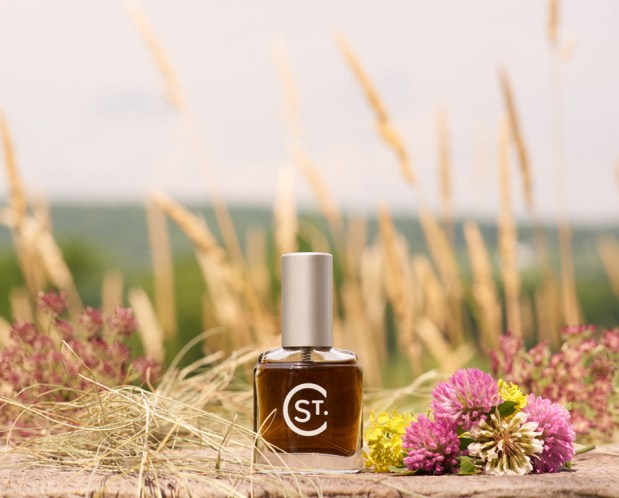Diane St. Clair is a dairy farmer and artisan maker of butter so good that she supplies it to the legendary French Laundry restaurant, among others. She is also now an artisan perfumer, having launched her first three scents earlier this year under the name St. Clair Scents. I’ve already written about Gardener’s Glove; today, I’ll take a look (or sniff!) at First Cut.
The name refers to the first mowing of a hayfield, in late summer. This is an important time at a dairy farm, as the mown hay will provide fodder for the cows during the winter. Here is the description of First Cut from St. Clair Scents’ website:
The hay harvest is the focus of every dairy farmer’s summer, keeping the fields regenerating and providing hay for the cows in winter.
The mowing and drying of native grasses, clovers, wild flowers, and legumes takes three days of sunshine and many hours of hard work.
This scent is of meadows, herbaceous and green, with wild flowers strewn throughout and splashed with radiant sunshine.
- Top Notes: Bergamot, Yuzu, Rosemary, Basil, Tomato Leaf Absolute
- Middle Notes: Lavender Absolute, Rose De Mai, Rose Geranium, Immortelle Absolute
- Base Notes: Hay Absolute, Tobacco Absolute, Oakmoss, Vanilla Absolute
The opening is strong and appealing — so much so, that my husband suddenly asked, after I had dabbed some on my wrist, “What smells so good?” The bergamot and yuzu really pop. I don’t normally like yuzu in fragrance, but here it really works, as it is dominated by the bergamot I prefer, and accompanied by the herbal notes of rosemary, basil, and tomato leaf. I can’t really pick out the rosemary and basil separately, but all the top notes blend harmoniously into a bright, herbal announcement that something special has arrived.
Kafkaesque offers her usual in-depth, insightful analysis, noting that First Cut merges aspects of both a traditional “fougere” fragrance and a “chypre”. As fougere scents more traditionally appear in men’s fragrances, I’m not as familiar with them, so I’ll share some of what I have learned. Most notably, the classic fougere includes a strong presence of lavender combined with oakmoss and coumarin, the latter widely considered to evoke the scent of sweet hay. And no wonder, based on this information from Fragrantica:
Coumarin … is a synthesized material in most perfumes, but it’s also found in abundance in natural products, such as tonka beans (Dipteryx odorata) where it is the principle aromatic constituent (1-3%). In fact the name derives from “cumaru”, an Amazonian dialect name for the Tonka bean tree. But that’s not all: apart from tonka beans, coumarin also occurs naturally in “vanilla grass” (Anthoxanthum odoratum), sweet woodruff (Galium odoratum), sweet clover (Meliotus L.), sweet grass (Hierochloe odorata) and cassia cinnamon (Cinnamomum aromaticum) among other species.
First Cut is all about hay, and there among the base notes is “hay absolute”, so we see the relationship to a classic fougere, together with the traditional lavender, oakmoss, and tobacco notes. Unlike a traditional fougere, though, here the lavender is clearly present but not dominant, which I prefer.
In my review of St. Clair Scents’ Gardener’s Glove, I described the meadow that bordered my father’s vegetable garden, the garden that Gardener’s Glove evoked for me. First Cut evokes that meadow and the same sense of a French potager, an enclosed garden that includes vegetables, flowers, fruits, and herbs. This potager, however, is not in New England but in the South of France, with its classic Mediterranean notes of lavender, rosemary, basil, rose de Mai, and citruses. It is on a farm, bordered by hay meadows and lavender fields which figure as much in this fragrance as the kitchen garden.
One of the many interesting things about First Cut is that it dries down in a way that mimics the maturing of a hayfield! The initial phase is very fresh, herbal and green, especially with those green herbs and tomato leaf absolute, like the fresh greenness of early summer. The middle stage is more floral, but in the way that midsummer clover is “floral”, nothing like the Big White Flowers. I think it is the immortelle that starts making the fragrance feel drier, as the middle stage leads into a base of dry tobacco, dry hay, dry oakmoss (and vanilla, which adds the creaminess and sweetness that Kafkaesque noted, and balances the dry notes). I love this creative progression and how it summons up the months from early summer through the peak of summer, ending with the late summer hay harvest known as the “first cut.” Brilliant! Even the lingering sweetness in the base is reminiscent of late summer honey from bees that have gorged on meadow flowers. I wonder if Diane St. Clair keeps honeybees?
I like First Cut very, very much — and if you are a man, or have a man in your life, who loves fougeres, try this! So far, of the two St. Clair Scents I have really tested, my heart still belongs to Gardener’s Glove, but First Cut is beautiful, pleasing, and clever all at once. As the late great perfumer Guy Robert is said to have told many people: “Un parfum doit avant tout sent bon (A perfume must above all smell good).” First Cut smells very, very good.
Samples kindly provided by St. Clair Scents; opinions are my own.












